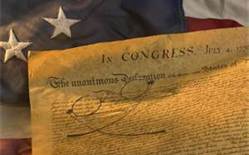 So, recently, I have been watching the Nightly Business Report (PBS) religiously, following Wall Street Journal and Financial Times articles, and I purchased a book by someone I feel gives an objective and informed look at politics and economics. That person is Arthur Laffer, and the book, "Return to Properity". It is a great read, in layman's terms, and he is fair and honest regarding both sides of the political spectrum. He reveals a common sense approach to our current world situation from an economics approach. Some it is so "common-sense" that you want to hit yourself on the forehead, and say, "YES, I get it!"
So, recently, I have been watching the Nightly Business Report (PBS) religiously, following Wall Street Journal and Financial Times articles, and I purchased a book by someone I feel gives an objective and informed look at politics and economics. That person is Arthur Laffer, and the book, "Return to Properity". It is a great read, in layman's terms, and he is fair and honest regarding both sides of the political spectrum. He reveals a common sense approach to our current world situation from an economics approach. Some it is so "common-sense" that you want to hit yourself on the forehead, and say, "YES, I get it!"
Interestingly enough, he refers to a historic figure from the 18th Century, David Ricardo, who lived from 1772-1823. An English political economist and stock trader, he was a member of Parliament, a business man and financier. He amassed a considerable fortune.
His most important contribution was the LAW OF COMPARATIVE ADVANTAGE, a fundamental law in favor of free trade among counties and of specialization among individuals. This law refers to the ability of a person or country to produce a particular good or service at a lower marginal and opportunity cost over another. Even is one country is more efficient in the production of all goods than the other, BOTH countries will still gain by trading with each other, as long as they have different relative efficiencies.
Ricardo wrote a book "On the Principles of Political Economy and Taxation, that gives an interesting example of trade between England and Portugal:
"In Portugal it is possible to produce both wine and cloth with less labor than it would take to produce the same quantities in England. However the relative costs of producing those two goods are different in the two countries. In England it is very hard to produce wine, and only moderately difficult to produce cloth. In Portugal both are easy to produce. Therefore while it is cheaper to produce cloth in Portugal than England, it is cheaper still for Portugal to produce excess wine, and trade that for English cloth. Conversely England benefits from this trade because its cost for producing cloth has not changed but it can now get wine at a lower price, closer to the cost of cloth. The conclusion drawn is that each country can gain by specializing in the good where it has comparative advantage, and trading that good for the other."
 Of course, these theories are always tested in the "real" world, and they include subtleties and nuances that will have a particular effect, but all in all, it gives us something to think about, when we are tending, or perhaps rushing toward isolationism and protectionism in the US. It is a bad policy not to know or care (in our arrogance) what's going on with different countries and their political systems. If we do not have "to-do's" with them, trade being a great way to be involved, then we miss the boat. We miss the chance to know first hand what they are up to, and we miss the opportunity to "help" each other. And, as Sun-tzu (Chinese general and military strategist 400bc) once said, "Keep your friends close, and your enemies closer." Or, for biblical scholars, from Luke 19:43, " The days will come upon you when your enemies will build an embankment against you and encircle you and hem you in on every side."
Of course, these theories are always tested in the "real" world, and they include subtleties and nuances that will have a particular effect, but all in all, it gives us something to think about, when we are tending, or perhaps rushing toward isolationism and protectionism in the US. It is a bad policy not to know or care (in our arrogance) what's going on with different countries and their political systems. If we do not have "to-do's" with them, trade being a great way to be involved, then we miss the boat. We miss the chance to know first hand what they are up to, and we miss the opportunity to "help" each other. And, as Sun-tzu (Chinese general and military strategist 400bc) once said, "Keep your friends close, and your enemies closer." Or, for biblical scholars, from Luke 19:43, " The days will come upon you when your enemies will build an embankment against you and encircle you and hem you in on every side."We generally NEVER learn from history. We think we know better, but human nature is human nature. Things always go better when we look our adversary or competitor in the eye and try to find a way to shake hands, find some common ground. It becomes a win-win for all.



























,_2nd_president_of_the_United_States,_by_Asher_B__Durand_(1767-1845)-crop.jpg)















